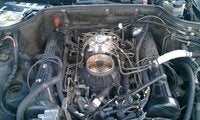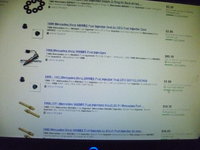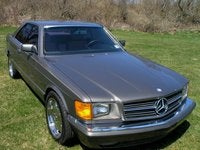my 1986 mercedes 560 sec isn't getting any fuel to cylinder #4. What is the most likely problem?
19 Answers
How would I know if it was a jetronic-k?
migration_judge_roy answered 11 years ago
well it's a mostly mechanical fuel injection system....everyone used them, Volvo, Porsche, Fiat, Volkswagen...mercedes?, Nissan....26 parts of excellence~ think perhaps 1988 was the last year that Porsche used them to know that it is specifically the number 4 cylinder and specifically the fuel injector would have me takin' that one apart to find the blockage~
migration_judge_roy answered 11 years ago
http://en.wikipedia.org/wiki/Jetronic
migration_judge_roy answered 11 years ago
jeez....looks like you DO have a K-jetronic....and that was just a wild burro guess~
migration_judge_roy answered 11 years ago
quite a few of my former cars had the jetronic...VW Quantum, Datsun 810, Fiat 850, Nissan Altima Volvo 240~ I should be able to speak with some authority on them, but haven't had trouble with ANY of them....had an 5 cylinder Audi with a bad thermo-time switch, but my involvement WITH them has been minimal~
Here's a pic of the engine. OK, I will look at the line leading to that injector, and the injector itself for blockage or problems. Thanks!
I agree with Roy, I think there might be a blockage in the injector.
who says no fuel, a misfire can be no compression. if no fuel it would be the injector tip clogged or faulty injector!
migration_judge_roy answered 11 years ago
OY, that's definately a jetronic~~!
migration_judge_roy answered 11 years ago
the way these things work is the "fuel distributor" pressurizes each injector, which has a release that will let go when the pressure gets to be sufficient to "spray" the fuel in~....jeez, change the fuel filter~
migration_judge_roy answered 11 years ago
Good point 7Jimmy7, this may NOT have come through the fuel...I'd be takin' that bad boy apart on my workbench and spraying it with some volatiles that would probably get you high if there wasn't proper ventilation~
migration_judge_roy answered 11 years ago
Gasoline is pumped from the fuel tank to a large control valve called a fuel distributor, which separates the single fuel supply pipe from the tank into smaller pipes, one for each injector. The fuel distributor is mounted atop a control vane through which all intake air must pass, and the system works by varying fuel volume supplied to the injectors based on the angle of the air vane, which in turn is determined by the volume flowrate of air past the vane, and by the control pressure. The control pressure is regulated with a mechanical device called the control pressure regulator (CPR) or the warm-up regulator (WUR). Depending on the model, the CPR may be used to compensate for altitude, full load, and/or a cold engine. On cars equipped with an oxygen sensor, the fuel mixture is adjusted by a device called the frequency valve. The injectors are simple spring-loaded check valves with nozzles; once fuel system pressure becomes high enough to overcome the counterspring, the injectors begin spraying.
migration_judge_roy answered 11 years ago
here's some parts if you want to play tinkertoy~
simplest system ever produced, and reliable too, replaced by low cost plastic components with a high margin of profit , hmmmmm!
simple ,the higher the the pressure the higher the needle tip lifts ,the more fuel passes the faster it goes, the more air intake passing the disc raising the pressure! sounds like a viscous cycle, it is till you close the throttle and starve the beast
migration_judge_roy answered 11 years ago
I don't know about "starve", but limit to idle speed, yeah---It about sums it up~
migration_judge_roy answered 11 years ago
kinda cool that these CAN be serviced in the first place~


